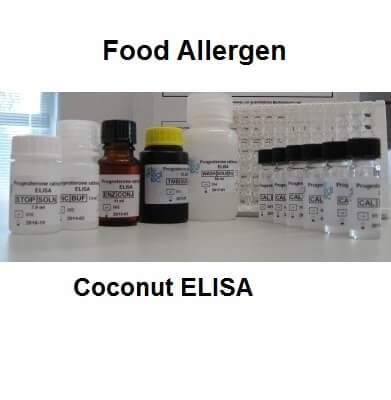PRODUCT DESCRIPTION
Pammvi is the authorised suppliers, agents, dealers and wholesalers for Coconut Allergy ELISA Test.
The Cocos palm (Cocos nucifera) belongs to the family of Areaceae. With about 3.3% the fraction of proteins in coconut is relatively low compared to other nuts. Some of these proteins are known for being allergenic. Compared to other nuts these proteins are still slightly characterized. Coconut allergies are relatively seldom, but can be very distinct in particular cases.
For coconut-allergic persons hidden coconut allergens in food are a critical problem. Already very low amounts of coconut can cause allergic reactions, which may lead to anaphylactic shock in severe cases. Because of this, coconut-allergic persons must strictly avoid the consumption of coconut containing food. Cross-contamination, mostly in consequence of the production process, is often noticed. This explains why in many cases the existence of coconut residues in food cannot be excluded. For this reason sensitive detection systems for coconut residues in foodstuff are required.
The Coconut ELISA represents a highly sensitive detection system for coconut and is particularly capable of the quantification of residues in cookies, cereals, ice-cream, chocolate and sausage.
Principle of the Test
The Coconut quantitative test is based on the principle of the enzyme linked immunosorbent assay. An antibody directed against coconut proteins is bound on the surface of a microtiter plate. Coconut containing samples or standards are given into the wells of the microtiter plate. After 20 minutes incubation at room temperature the wells are washed with diluted washing solution to remove unbound material. A peroxidase conjugated second antibody directed against coconut proteins is given into the wells and after 20 minutes of incubation the plate is washed again. A substrate solution is added and incubated for 20 minutes, resulting in the development of a blue colour. The colour development is terminated by the addition of a stop solution, and the colour turns yellow. The yellow colour is measured photometrically at 450 nm. The concentration of coconut is directly proportional to the colour intensity of the test sample.
Enzyme Immunoassay for the quantitative determination of Coconut in food
| Technology | : ELISA |
| Kit size | : 96 wells |
| Sample material | : food |
| Sample preparation | : extraction, dilution, centrifugation |
| Sample volume | : 100 µl |
| Standard range | : 2 – 30 ppm |
| Incubation | : 20, 20 (RT), 20 min (RT/dark) |
| Measuring system | : TMB at 450 nm |
| Sensitivity | : 0.4 ppm |



